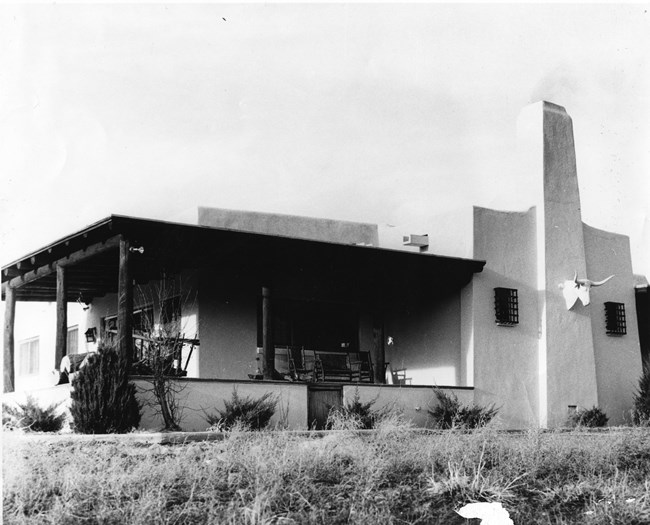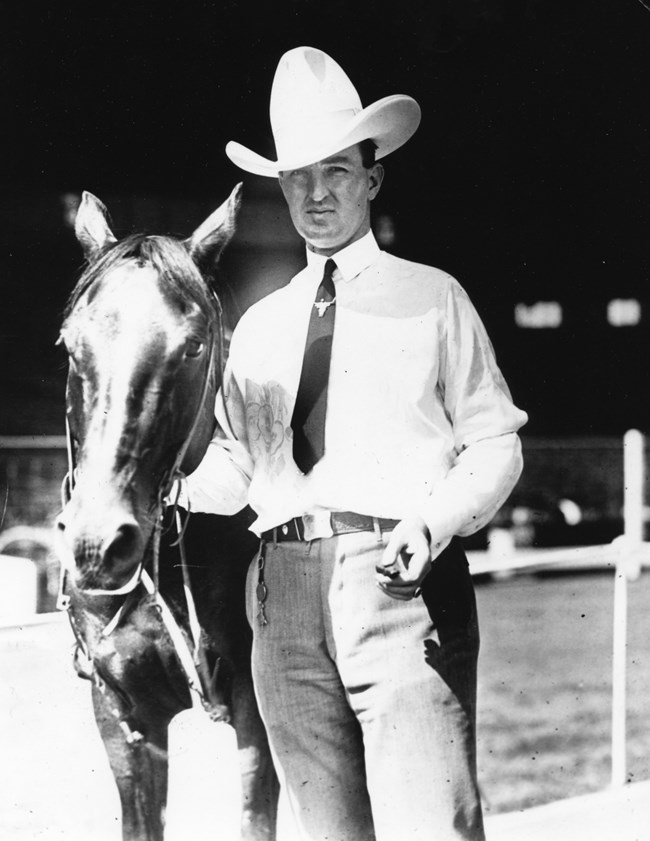|
For hundreds of years the land along the Pecos River nourished and served the needs of the inhabitants and settlers of the region. The Forked Lightning Ranch, which is part of Pecos National Historical Park, is an important part of that story.
Early History
After the arrival of the Spanish in 1598, the area that now includes Pecos National Historical Park became part of the Viceroyalty of New Spain, and later a territory of the Republic of Mexico. When the Republic of Texas seceded from Mexico in 1836, it claimed the territory in an unratified treaty. The United States therefore also claimed the area in 1845 when the United States annexed the Republic of Texas. The area was not fomally acquired until the Treaty of Guadalupe Hildalgo in 1848. 
NPS Photo During the nineteenth century, as Pecos Pueblo declined in population, settlers from Mexico and the United States began to occupy the lands along the Pecos River. The settlers often claimed land without regard to the formalities of deeds or land titles. Among these was a Polish immigrant named Martin Kozlowski. In 1858, he built a trading post and way station alongside the Santa Fe Trail just two miles from Pecos Pueblo. There are unconfirmed stories that he used timbers from the Pecos Mission Church in the construction of the building. 
NPS Photo During the Civil War, the Union Army used Kozlowski's Trading Post as a headquarters during the Battle of Glorieta Pass and as a hospital for soldiers wounded in the battle. The property remained in the Kozlowski family until the 1920s.
The Tex Austin Era
In 1925, a colorful entrepreneur purchased parcels of land along the river, including Kozlowski's Trading Post. He took the name of Tex Austin and created the Forked Lightning Ranch. He used the Trading Post as the Ranch headquarters and hired architect John Gaw Meem to design and build a ranch house on the bluff overlooking the confluence of the Pecos River and Glorieta Creek. Meem, who later became a renowned Southwestern architect, designed the house in Pueblo Revival Style, with rooms surrounding a central patio. At Austin's request, Meem designed an ornamental head of a longhorn steer for the living room, but when the head proved too large for the interior space, it was relocated to the front of the building, where it continues to grace the entrance to the ranch house.

NPS Photo Austin, who became a well-known international promoter of rodeos, operated the Forked Lightning Ranch as an upscale dude ranch and resort. He advertised the ranch house as "modern in every detail," with "every room open on both sides." "Each room has electric lights, modern heating and plumbing, and between each two bedrooms is a bathroom with running hot and cold water." The rooms included "box mattress beds as well as all other conveniences anyone would wish in a well-appointed house." The ranch offered guests "food, lodging, saddle horses, guides, instructor (if needed), use of polo practice field, horseback picnic trips, motor trips to Santa Fe, the Indian pueblos, or any and all points of interest within 50 or 75 miles of the ranch." Riding outfits, hats, boots, and equipment could be purchased at the Trading Post and Ranch Store.
But not just anybody could enjoy Forked Lightning Ranch. The Ranch's guest list included such natoable figures of the time as Col. and Mrs. Charles Lindbergh and Will Rogers, and brochures cautioned that "[t]he accommodations... are for the recreation of healthy people and no health seekers will be received." Another brochure announced that "[t]here are accommodations for only a very limited number of guests and no one will be received without references."
The Fogelson Era
In 1941, the Forked Lightning Ranch was purchased by Col. Elijah Edwin "Buddy" Fogelson, a Texas oilman and rancher. Originally comprising 5,500 acres, Fogelson eventually expanded it to about 18,000 acres. He used the ranch house as his residence and the Kozlowski Trading Post as quarters for the ranch foreman. In 1949 Fogelson married Hollywood actress Greer Garson, and the couple used the property as their part-time residence for the rest of their lives.
Forked Lightning operated as a working ranch, at first raising Hereford cattle. In 1950, Greer Garson Fogelson imported a small herd of white Shorthorn cattle from Scotland, but they proved unable to withstand the climate. In 1958 Buddy Fogelson purchased a registered Santa Gertrudis bull named "Gee-Gee" and three heifers. The Santa Gertrudis breed, about 3/8 Brahmin and 5/8 Shorthorn, was originally developed on the King Ranch in Texas and is known for its ability to endure harsh climates. The Santa Gertrudis thrived at Forked Lightning Ranch and won prizes at the New Mexico State Fair. During the 1960s, the Fogelsons determined that polled (hornless) stock would be more popular among feedlot operators, and began raising and breeding a strain of polled Santa Gertrudis cattle.
In addition to serving as a working cattle ranch, Forked Lightning was a social center for entertaining the rich and famous. Lavish parties included chuckwagon picnic lunches on the banks of the Pecos River or evening fiesta buffets on the patio, hunt breakfasts, and afternoon teas. The Fogelsons constructed a skeet shooting range above the ranch house in the 1950s. Hollywood celebrities, politicians, artists, and philanthropists visited the ranch, including Art Linkletter, Merle Oberon, Vincent Minnelli, David O. Selznick, Winthrop Rockefeller, and Georgia O'Keeffe. Forked Lightning Ranch and Pecos National Historical Park
After Buddy Fogelson died in 1987, the Forked Lightning Ranch was divided between Greer Garson Fogelson and Buddy's son Gayle. In 1989, Mrs. Fogelson was in declining health and it was announced that a Florida developer planned to purchase the property and develop a resort community. The community - "Santa Fe East 2001" - would include a private hunting reserve, two golf courses, a shopping center, a race track for cars and motorcycles, an airport, and housing developments. Following protests from the local community and press, however, Mrs. Fogelson "reconsidered" the transaction and decided instead to sell the property to The Conservation Fund, which purchased the ranch with funds provided by the Richard King Mellon Foundation. The Conservation Fund donated the land to the federal government and the ranch became part of Pecos National Historical Park.
Greer Garson Fogelson last visited the Ranch in 1990. Although some original furnishings and items remain in the ranch house, many of the ranch's furnishings were sold at auction, including photos of celebrities, original artwork, santos, Navajo blankets, hand-crafted furniture, baskets, lamps, Buddy's gun collection, and a set of "his and hers" saddles.
Today, the park offers occasional tours of the Ranch House and Kozlowski's Trading Post. |
Last updated: January 22, 2021
